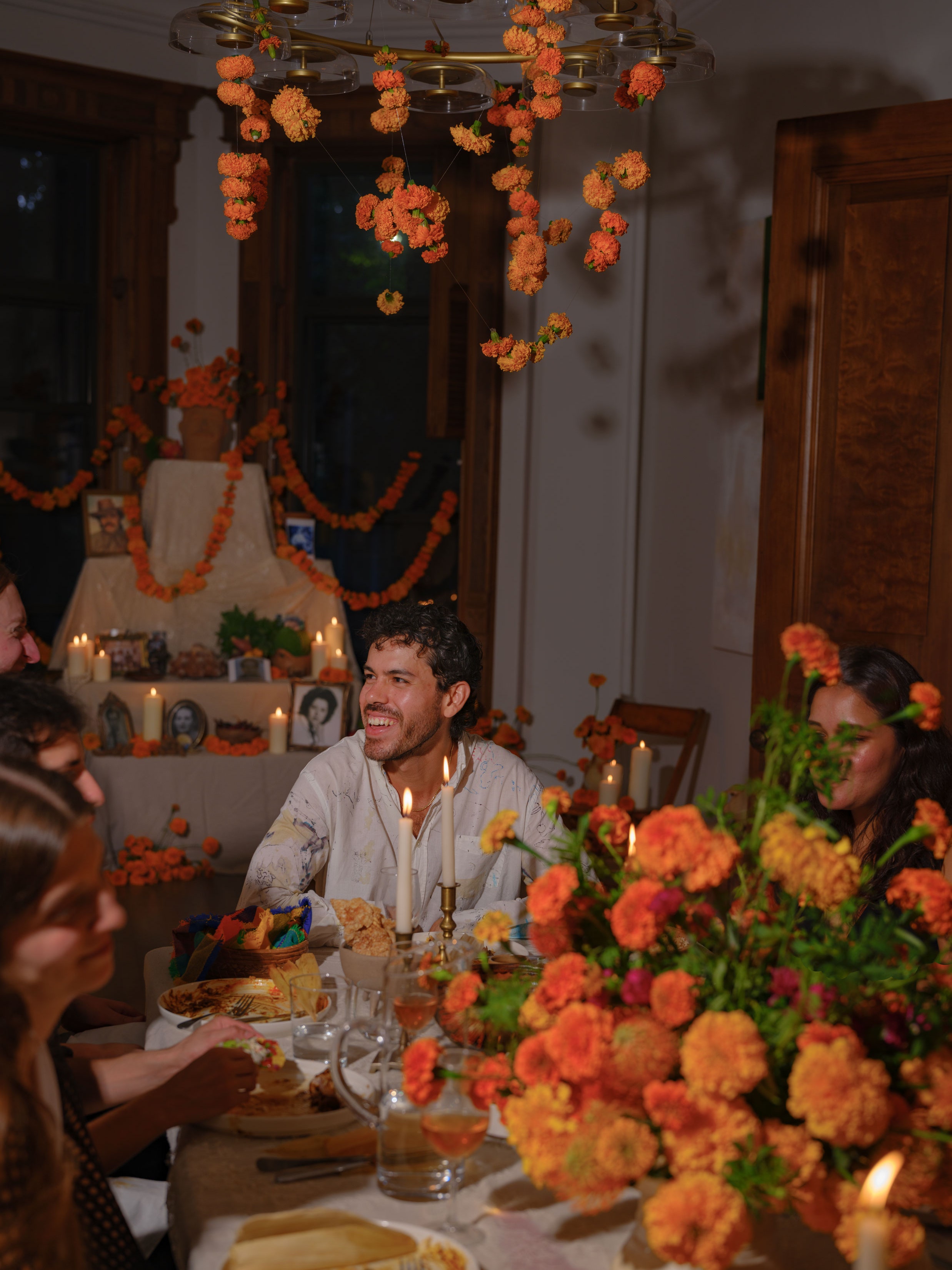For Hazel Zavala, art director at Bon Appétit, Mexico never feels closer or farther away than on November 1. Día de Muertos, an autumnal tradition, invites the dead back to the world of the living. It’s a time when cemeteries across the country blossom into life, when cempasúchiles, or marigolds, are placed in bushels atop tombs, and candlelit parties go well into dawn. Ofrendas—elaborate altars to the dead—are heaped high with sweet bread, fruit, flowers, and the favorite dishes of departed loved ones, like mole, enfrijoladas, and tamales. After moving to New York seven years ago, Zavala wondered: Could these rituals be just as potent when reimagined elsewhere?
Zavala grew up in Michoacán, a region where rural communities have passed down the holiday’s customs and recipes for generations. “My family used to live close to the cemetery,” he said. “Every year we would have lunch there with the other families, play music, drink, and hang out for hours.” He remembers driving to Pátzcuaro too, where the ancient city’s plaza teemed with food stalls and sugar skulls, while La Catrina skeletons wove through the bustling crowds. Throughout this time he paid his respects, honoring cultural figures or distant relatives he’d never met. Then, in 2018, Zavala’s father passed away, forever altering his relationship to the home, and traditions, he’d left behind.
It was this sense of loss that inspired a ritual of Zavala’s own: a remembrance dinner. I joined him and nine of his friends for the occasion one balmy evening at a Bed-Stuy, Brooklyn, brownstone. Upon entering I was met with the aroma of copal, a tree resin burned as incense. Turning the corner revealed the ofrenda, its tiers resplendent with cempasúchiles, candles, photos, gifts of dried chiles, fresh tamarind pods, epazote, dragon fruit, and nopales.
In Día de Muertos tradition, it is believed that smell—the incense, the food, the flora—guides souls from Mictlán, the world of the afterlife, on their journey home. At Zavala’s dinner, this was also true of the living. “Our senses are so strong,” Zavala said. “I smell the copal, the flowers, and it feels like I’m back.”
Zavala hosted the first of these meals after the pandemic lockdown. “It started out as me wanting to do an altar,” Zavala said. “But then my roommate was like, ‘I would love to make my dad’s favorite pasta dish,’ and then we both did a dish, and we put up our photos and had a nice night.” It was intimate, with only four people, but the event was compelling enough to repeat the next year. As the remembrance dinner grew, so did the altar, which hosted more and more relatives and offerings
On this night, Zavala’s friend Carolina contributed a roll of Colombian pesos because her abuela loved counting money, coin by coin. Zavala furnished the nearby dinner table with savory calabacitas and bean tamales, once favored by his father, Francisco, whose handsome sepia portrait watched over our festivities.
Guests trickled in. Some knew each other, some didn’t. But the sights and sounds and smells worked their magic, and talk came easily around the altar. Music featuring classics from Juan Gabriel, Daniela Romo, and Luis Miguel (por supuesto) filled gaps of chatter. Spanish and English commingled like old friends: Which part of Mexico? Ah, a norteño. I’ve never been. Remember this song? Oh God, my parents played it every single day. Hold on. Quiero cantar esta parte.
When Zavala took his seat at the head of the table, there was no big speech, nor the somberness one might expect at a ceremony centered on the dead. Between the clinking of glasses and the compliments for each other’s cooking, there remained a palpable sense of what remained unspoken: the longing for a country left behind, of loved ones lost, all briefly regained in a night of small gestures.
Wine bottles made the rounds, accompanied by mezcal, orange slices, asado de puerco, shrimp ceviche, and tomato pie, each a tribute to a story, a life. The bullfighter grandfather with a sweet tooth, the abuela who loved to sing “Que Será, Será,” a father whose memory endures in his spitting image: his son. This is what makes Zavala’s remembrance dinners so powerful; they bring warmth to the progress of grief, making space for the act of remembering to be joyful and full of life.
The night carried on in this spirit. Applause erupted when the flan appeared, along with a gorgeous pan de muerto (the traditional bread of the dead) from La Newyorkina, its ornate sculptural facade an ode to the circle of life. Then, once the coconut paletas, conchas, and capirotada were devoured, hugs and kisses exchanged, and leftovers meted out, the evening formally drew to a close. Yet outside, gathered in the dark, the guests all lingered by the front door a while longer, not quite ready to say goodbye.
These tips can help you host a meaningful night of your own.
- While traditional ofrendas include many symbolic adornments, Zavala suggests making one that feels true to you.
- The altar’s structure can be adaptable to what you’ve got on hand. Use fabric and old boxes to create levels and a solid base.
- Display framed photos of loved ones alongside candles, incense, and fresh flowers—scents that are said to guide spirits home.
- Leave offerings such as personal objects, a relic, special token, snacks and/or drinks significant to the honorees.
- For the meal, each guest should bring a dish that represents their loved one’s favorite food.
- Dedicate a moment for sharing stories, or follow Zavala’s lead and let chitchat around the ofrenda happen organically.
